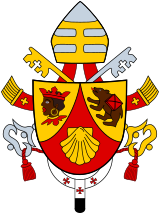I quite like the sound of the name Saint Cloud, whom we celebrated yesterday – ethereal and heavenly, fitting for these last days of summer. His original name was actually Clodoald, a sixth-century hermit (+560), who was of royal lineage – the grandson of Saint Clovis – who renounced the world and became a hermit, settling down just outside of Paris – where the region is named after him – amongst the fishermen and farmers, founding a church dedicated to Saint Martin of Tours, around which a monastery soon grew.
Today, on Our Lady’s birthday – and a blessed one may it be – we also celebrate the early martyrs Saint Adrian (+306) – or Hadrian, not to be confused with the earlier emperor of that name – who was head of the elite Herculian Guard under Emperor Galerius Maximian, tasked with torturing Christians to death. He was so impressed by their hope and courage that he converted on the spot, and was duly sent to prison and put to death himself. His wife, Natalia, was allowed to visit him, dressed as a boy, beseeching his prayers once he entered heaven. She is often portrayed with him in art, as a fellow quasi-martyr, as, we may suppose, a companion in her husband’s suffering, and being faithful to him.
And we should mention Saint Corbinian, an eighth century missionary bishop (+730), sent by Pope Gregory II to evangelized the pagans of Bavaria (He was contemporaneous with Saint Boniface, who was in the same region preaching to the Frisians). Corbinian was made the first bishop of Freising, where Josef Ratzinger would, centuries later, also be named bishop. You may notice that Ratzinger chose as part of his episcopal-and-papal-arms a saddled bear, which goes back to the legend that said bear killed Corbinian’s horse, and then, in apparent contrition, submitted to carrying Corbinian on his pilgrimage to Rome, after which he was set free. Ratzinger said that he too had been ‘tamed by God’. One wonders what he would have been like had he not been.

source: wikipedia.org









